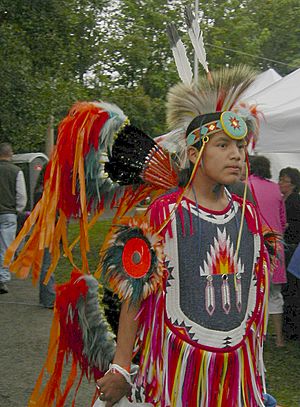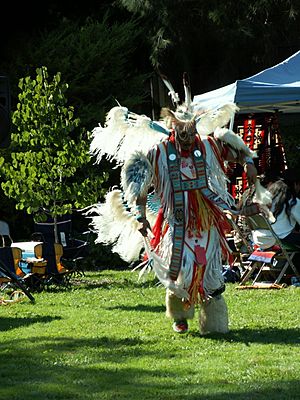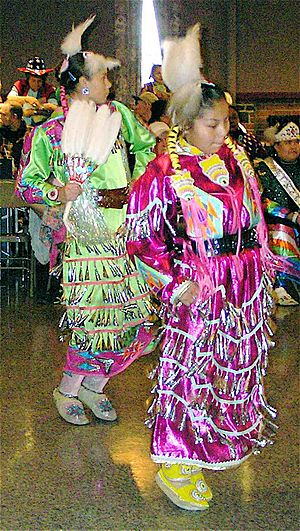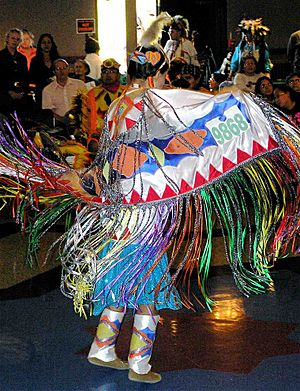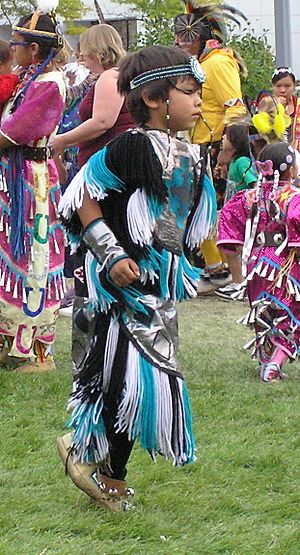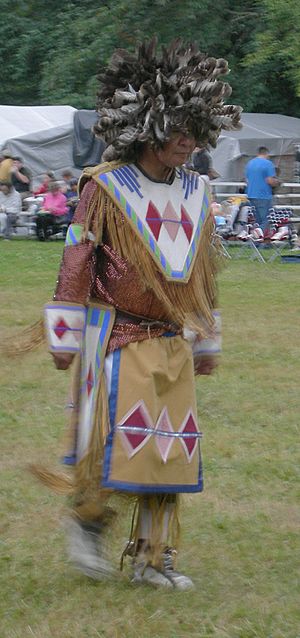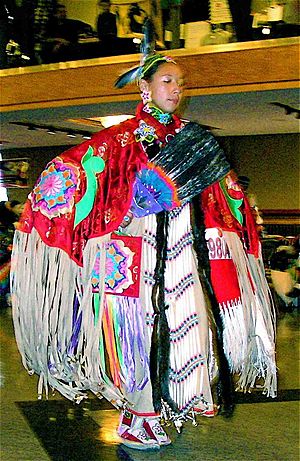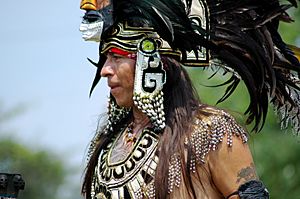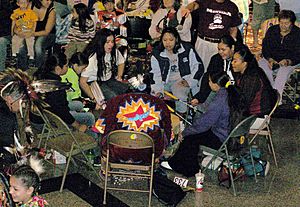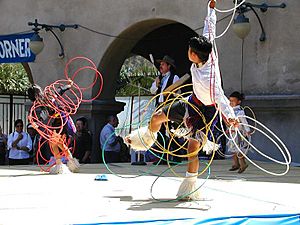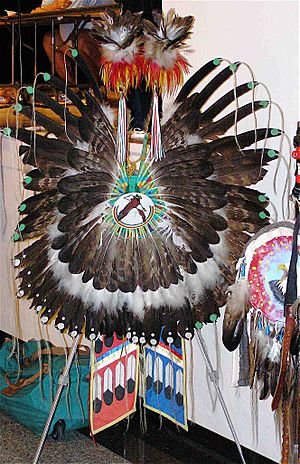Pow wow facts for kids
A powwow (also spelled pow wow or pow-wow) is a special gathering held by many different Native American communities. It's a time for Native American people to come together. They dance, sing, socialize, and celebrate their cultures. Powwows can be private, just for community members, or public, where everyone is welcome.
Often, powwows include dancing competitions. There are many types of traditional dances, music, and special outfits called regalia. Sometimes, winners even get prize money! Powwows can last for just one day or up to a week for big, special events.
Sometimes, in old movies, the word "powwow" was used to mean any meeting of Native Americans. It was also used for any kind of meeting, like among soldiers. This use is not encouraged today. It can make the important cultural meaning of powwows seem less special.
Contents
History of Powwows
The word "powwow" comes from the Narragansett people's word powwaw. This word means "spiritual leader." The word has been spelled in different ways over time, like Powaw or Pawau.
Many Native American tribes say they held the "first" powwow. Public dances that look like today's powwows were most common in the Great Plains area of the United States. This was in the late 1800s and early 1900s. At that time, the United States government tried to break up many Native communities. They wanted to take their land.
In 1923, a government official named Charles Burke made a rule. It limited when Native Americans could practice traditional dances. He thought these dances were a threat to the Christian religion. But many Native communities kept meeting in secret. They continued to practice their cultures' dances and music, even though it was against the rules. By the mid-1800s, powwows were also happening in the Great Lakes region.
How Powwows Are Organized
Planning a powwow usually starts many months, or even a year, before the event. A group of people called the powwow committee does all the planning.
Powwows can be sponsored by different groups. These include tribal organizations, Native American communities in cities, or Native American clubs at colleges or university campuses. Any group that can help with money, insurance, and volunteers can sponsor a powwow.
The Committee
The powwow committee is made up of people who plan everything before the event. If a tribe or college sponsors the powwow, many committee members might come from that group.
The committee's jobs include:
- Finding and hiring the main staff for the event.
- Telling people about the powwow.
- Finding a place to hold the powwow.
- Inviting vendors who pay to sell food or goods at the event.
The Staff
The head staff are the people who run the powwow on the actual day or days it happens. The committee usually hires them months ahead of time. This is because good staff can help more people come to the powwow. Being chosen as part of the head staff is a great honor. It shows respect for a person's skills or dedication.
Arena Director
The arena director is in charge during the powwow. Sometimes they are called the whip man, or the whip man is their helper. The arena director makes sure dancers are dancing. They also tell the drum groups what kind of song to sing.
If there are contests, the arena director is responsible for finding judges. They often have an assistant who is the head judge. The arena director also organizes any special ceremonies. For example, if an eagle feather falls, they handle the ceremony for it. A main duty is to make sure the dance area is treated with respect by everyone.
Master of Ceremonies (MC)
The master of ceremonies, or MC, is the voice of the powwow. Their job is to keep everyone informed. This includes the singers, dancers, and the public. The MC sets the schedule for events. They also manage the drum rotation, which is the order of when each drum group sings. The MC also fills any quiet times during the powwow, often by telling jokes. They often run raffles or other contests too.
Head Dancers
The head dancers include the Head Man Dancer and the Head Woman Dancer. There are often Head Teen Dancers, Head Little Boy and Girl Dancers, and Head Golden Age Dancers. If the powwow has a Gourd Dance, there might also be a Head Gourd Dancer.
The head dancers lead all the other dancers in the grand entry. This is a parade of dancers that starts the powwow. Often, head dancers also lead the dancers during songs. Many dancers won't enter the arena unless the head dancers are already dancing.
Host Drums and Drum Groups
The singers sing while playing the drum. Host drums sing the songs at the beginning and end of a powwow session. This usually includes a starting song, the grand entry song, a flag song, and a veterans or victory song to begin. To end, they sing a flag song, a retreat song, and a closing song.
If a powwow has gourd dancing, the Southern Host Drum often sings all the gourd songs. Sometimes another drum can perform them. Host drums are often asked to sing special songs during the powwow.
The Powwow Event
Setup
A powwow is often set up in large circles. The center circle is the dance arena. Around this, there's a larger circle with the MC's table, drum groups, and sitting areas for dancers and their families. Beyond these two circles is an area for people watching. Outside of everything are vendor booths. Here, you can buy food like frybread and Indian tacos. You can also find music, jewelry, souvenirs, arts and crafts, beadwork, leather, and supplies for regalia.
At outdoor powwows, the main circle is often covered by a tent or arbor. This protects people from the sun or rain. It's very important to protect the drums. They are sensitive to temperature changes and must not get wet. Most vendors have their own tents at outdoor powwows.
Etiquette
There are rules for how to behave at a powwow, called powwow etiquette. These include rules about taking pictures and what to do during the Grand Entry. Here are some common guidelines:
- The special clothing worn by dancers is called "regalia," not a "costume."
- Drums have special rules. People who are not part of the drum group should not touch or play them.
- Do not touch people or their regalia without asking permission first.
- For photos or videos, always ask before taking them. Some tribes, like the Pascua Yaqui and Hopi, do not allow photos or sketches of their ceremonies at all.
Opening
A powwow session starts with the Grand Entry. In most cases, it also begins with a prayer. The Eagle Staff leads the Grand Entry. Flags follow, then the dancers. One of the host drums sings an opening song. This event is very special. Some powwows do not allow filming or photography during this time, but others do.
If military veterans or active soldiers are there, they often carry the flags and eagle staffs. After them come the head dancers. Then, the other dancers usually enter in a specific order: Men's Traditional, Men's Grass Dance, Men's Fancy, Women's Traditional, Women's Jingle, and Women's Fancy. Teens and small children follow in the same order.
After the Grand Entry, the MC will ask a respected community member to give a prayer. The host drum that didn't sing the Grand Entry song will then sing a Flag Song. This is followed by a Victory or Veterans' Song. During this song, the flags and staffs are placed at the MC's table.
Dances
The different dance styles at a powwow come from the traditions of the Great Plains nations in Canada and the United States. Besides the opening and closing dances, the most common is the intertribal. For this dance, a drum group sings a song, and anyone who wants to can come and dance.
Similar dances include the round dance and the crow hop. There are also "double beat," "sneakup," and "sidestep" dances for Women's Traditional and Jingle styles. Each of these songs has a different step, but dancers of any style can join in.
In addition to open dances, there are often contest dances. These are for specific dance styles and age groups. The top winners receive a cash prize. To compete, a dancer must wear the right regalia for their dance style. Bigger powwows have more specific categories. Dance categories vary by region, but general ones are:
Men's Dances
- Fancy Dance or Fancy Feather Dance (Northern and Southern styles): This dance has bright regalia and dramatic moves, like spins and leaps. Fancy dancers are known for their colorful outfits with two large bustles on their upper and lower backs.
- Northern Traditional (or "Men's Traditional" in the North): This dance uses traditional regalia, with one or no bustle. The movements tell stories from when the powwow was first danced by warrior societies of the Ponca and Omaha tribes.
- Straight dance (or Southern Traditional): Straight dancers often have neat outfits with handmade items like chokers and breastplates. Their dance steps are like Northern styles. They step on the ball of one foot, tap it once, then tap it again with their heel slightly off the ground. They repeat this with the other foot in a walking motion. It's hard to keep up with fast drums! If they get off beat, they tap their foot three times instead of two to get back in rhythm.
- Grass Dance: This dance features regalia with long, flowing fringe. The designs look like grass blowing in the wind. The dance movements are more detailed than traditional dancers but less flashy than fancy dancers.
- Eastern War Dance: This storytelling dance comes from the East Coast. Men do not wear a bustle but carry a fan and a dance stick. It's also called the "Eastern Strait Dance."
Women's Dances
- Traditional (seen at Northern powwows): This dance uses traditional cloth or leather regalia. Dancers perform with precise, very controlled movements.
- Buckskin and Cloth: A traditional dance from the South. The name refers to the material of the dress. The regalia is similar to the Northern traditional dance. In the South, buckskin and cloth dancers are judged in separate groups. The dance steps are the same for both.
- Fancy Shawl: This dance features women wearing bright colors and a long, often fringed and decorated, shawl. They perform fast spins and detailed dance steps.
- Jingle Dress (healing dance): The jingle dress has a skirt with hundreds of small tin cones. These make noise as the dancer moves with light footwork close to the ground.
Most intertribal dancing is done individually. But there are also dances for couples and groups. Couples dances include the two step and owl dance. In a two step, each couple follows the head dancers, forming a line behind them. In an owl dance, each couple dances alone. Group dances include the Snake and Buffalo dance. In this dance, the group moves to copy a snake at the start, then changes to copy a herd of buffalo.
At powwows where there is a large Southern Plains community, the Gourd Dance is often held before the main powwow sessions. The gourd dance started with the Kiowa tribe and then spread. It's a special dance for veterans and their families. Unlike other dances, the gourd dance is usually performed with the drum in the center of the dance arena, not on the side.
Music at Powwows
While many music styles are unique to different tribes, powwow music is often a mix of styles from different tribes. The music from the Plains Indians, who started the modern powwow, is very important. For more about dancing, see the Dances section.
Drumming
"Good drums get the dancers out there, good songs get them to dance well. Without drum groups there is no music. No music, no dance, no powwow."
There can be many drums at a powwow, especially at weekend or week-long events. But each powwow has a host drum that is given great respect. Members of drum groups are often family, extended family, or friends. Groups are often named after families, places, tribal groups, or more colorful names. Many groups show their names on jackets, hats, or chairs.
Traditionally, only men would drum, and women would sit behind them singing high harmonies. In the mid-1970s, women started drumming with men and singing an octave higher. Today, there are mixed-gender and all-female drum groups.
A drum group carries supplies like the drum, padded drum sticks, a drum stand, and folding chairs. Sometimes they also have a public address system. The drum head, stand, and microphone stands are often decorated with paintings, eagle feathers, fur, flags, or colored cloth strips.
You can easily notice the "hard beats" in songs. These are used to mark different parts of the song. In the "traditional method," all singers strike the drum strongly every other beat. These can appear at the beginning or end of a section. A group of three hard beats can mark the end of a series of hard beats. A few beats at the start of a song show the singers' excitement. In the "Hot Five" method, five beats are used. The first hard beat is four beats before the second, and then the beats alternate.
Drum Etiquette
To understand drum rules, think of a drum as a person or living being. It should be treated with great respect. Drum etiquette is very important. Rules can be different in different regions.
The drum is the main symbol at Oklahoma powwows. It is placed in the center of the dance floor and the powwow area, which are shaped in circles. Southern drums hang from four posts, one for each direction. Northern drums are set up outside the dance area, with the host drum in the best spot.
Drummer-singers are expected to stay at their drum and be ready to sing at any time. A dancer might come to the drum and whistle, fan, or gesture with their staff to ask for a song. This can happen even if it's not that drum group's turn to sing. In some areas, it's considered disrespectful to leave a drum completely alone. Some drum groups do not let women sit at their drum. However, they welcome women to stand behind the drummers and sing backup harmonies. The reasons for this come from different tribal stories about the history of drumming. When gifts of tobacco are offered to the drum during giveaways, musicians show respect by standing.
Singing
While the drum is key to powwows, "the drum only helps them keep beat. Dancers key on the melody of the song. Rhythms, tones, pitch all help create their 'moves'."
Most powwow songs use vocables. These are syllable sounds like "ya," "hey," and "loi." This is especially true for intertribal songs, like the AIM Song. These songs cannot favor one language over another.
A song usually has four pushups. This means the chorus and verse are sung through four times. In each chorus, the lead singer starts the melody. Another singer then joins in, adding variations before the leader finishes their first line. Then, the whole group joins for the rest of the pushup. Three down strokes or hard beats mark the end of the chorus and the start of the verse. During these, dancers might change their moves, like hopping low. An increase in speed and volume on the last five beats marks the end of the final verse. The dancing stops on the final beat. Then, a tail or coda finishes the song with a shorter chorus.
Sometimes, a drum group will sing a song more than four times. This happens if the song feels good, or if a dancer blows a whistle or passes their staff or fan over the drum. This signals that the song should continue for four extra pushups while they pray.
Singing styles differ by region. A high falsetto voice is used in the North, while a lower range is used in the South. To someone new to it, Native American singing might sound "exotic, different, and difficult to understand." This can be because the sound quality of traditional Native American music is different from European music. However, "to the trained ear, melodies flow, ascend and descend." Dancers react to changes in the melody and song structure.
Boye Ladd says, "If you give me a stink song, I'll dance stink. If you give me good music, I'll give you a great show." This means you can enjoy the music through the dancing, which everyone can appreciate. But others say that today's contest dancers are expected to dance their best no matter how good or bad the drum group is. Generally, Native American singing uses a pentatonic scale (like playing only the black keys on a piano). While it might sound like just drumming and "Heya-heya-heya-heya" to outsiders, sometimes there are actual words in languages like Cree, Pikuni, Lakhota, or many other Native languages.
Images for kids
-
Pow-Wow in Wendake, Quebec/Canada, 2014
See also
 In Spanish: Powwow para niños
In Spanish: Powwow para niños


